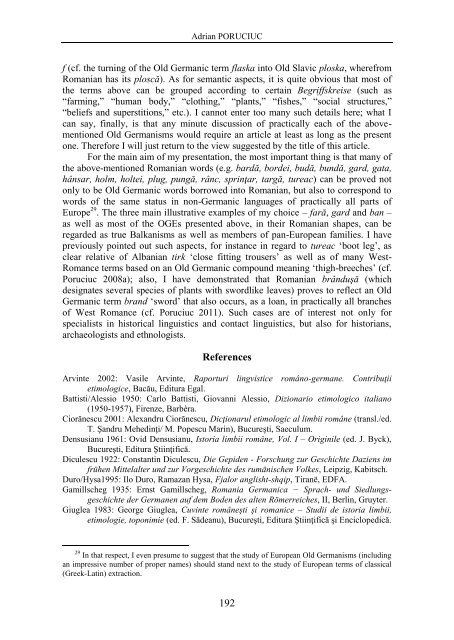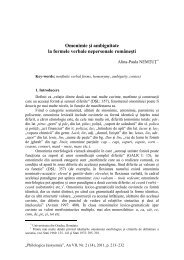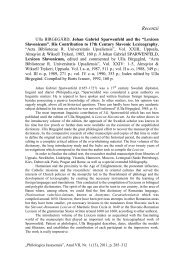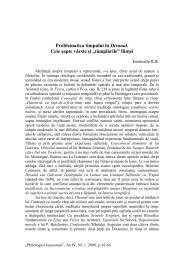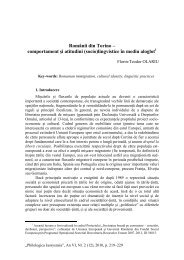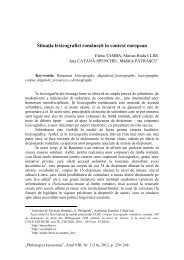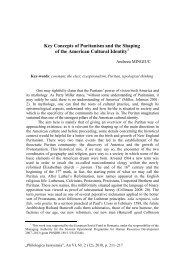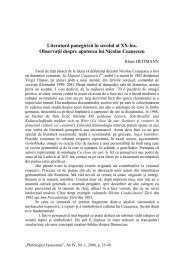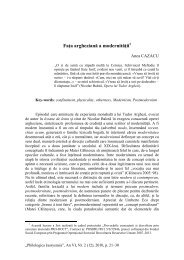O sutÄ de ani de cartografie lingvisticÄ româneascÄ - Philologica ...
O sutÄ de ani de cartografie lingvisticÄ româneascÄ - Philologica ...
O sutÄ de ani de cartografie lingvisticÄ româneascÄ - Philologica ...
Create successful ePaper yourself
Turn your PDF publications into a flip-book with our unique Google optimized e-Paper software.
Adrian PORUCIUC<br />
f (cf. the turning of the Old Germ<strong>ani</strong>c term flaska into Old Slavic ploska, wherefrom<br />
Rom<strong>ani</strong>an has its ploscă). As for semantic aspects, it is quite obvious that most of<br />
the terms above can be grouped according to certain Begriffskreise (such as<br />
“farming,” “human body,” “clothing,” “plants,” “fishes,” “social structures,”<br />
“beliefs and superstitions,” etc.). I cannot enter too many such <strong>de</strong>tails here; what I<br />
can say, finally, is that any minute discussion of practically each of the abovementioned<br />
Old Germ<strong>ani</strong>sms would require an article at least as long as the present<br />
one. Therefore I will just return to the view suggested by the title of this article.<br />
For the main aim of my presentation, the most important thing is that many of<br />
the above-mentioned Rom<strong>ani</strong>an words (e.g. bardă, bor<strong>de</strong>i, budă, bundă, gard, gata,<br />
hânsar, holm, holtei, plug, pungă, rânc, sprinţar, targă, tureac) can be proved not<br />
only to be Old Germ<strong>ani</strong>c words borrowed into Rom<strong>ani</strong>an, but also to correspond to<br />
words of the same status in non-Germ<strong>ani</strong>c languages of practically all parts of<br />
Europe 29 . The three main illustrative examples of my choice – fară, gard and ban –<br />
as well as most of the OGEs presented above, in their Rom<strong>ani</strong>an shapes, can be<br />
regar<strong>de</strong>d as true Balk<strong>ani</strong>sms as well as members of pan-European families. I have<br />
previously pointed out such aspects, for instance in regard to tureac ‘boot leg’, as<br />
clear relative of Alb<strong>ani</strong>an tirk ‘close fitting trousers’ as well as of many West-<br />
Romance terms based on an Old Germ<strong>ani</strong>c compound me<strong>ani</strong>ng ‘thigh-breeches’ (cf.<br />
Poruciuc 2008a); also, I have <strong>de</strong>monstrated that Rom<strong>ani</strong>an brânduşă (which<br />
<strong>de</strong>signates several species of plants with swordlike leaves) proves to reflect an Old<br />
Germ<strong>ani</strong>c term brand ‘sword’ that also occurs, as a loan, in practically all branches<br />
of West Romance (cf. Poruciuc 2011). Such cases are of interest not only for<br />
specialists in historical linguistics and contact linguistics, but also for historians,<br />
archaeologists and ethnologists.<br />
References<br />
Arvinte 2002: Vasile Arvinte, Raporturi lingvistice româno-germane. Contribuţii<br />
etimologice, Bacău, Editura Egal.<br />
Battisti/Alessio 1950: Carlo Battisti, Giovanni Alessio, Dizionario etimologico italiano<br />
(1950-1957), Firenze, Barbèra.<br />
Ciorănescu 2001: Alexandru Ciorănescu, Dicţionarul etimologic al limbii române (transl./ed.<br />
T. Şandru Mehedinţi/ M. Popescu Marin), Bucureşti, Saeculum.<br />
Densusianu 1961: Ovid Densusianu, Istoria limbii române, Vol. I – Originile (ed. J. Byck),<br />
Bucureşti, Editura Ştiinţifică.<br />
Diculescu 1922: Constantin Diculescu, Die Gepi<strong>de</strong>n - Forschung zur Geschichte Daziens im<br />
frühen Mittelalter und zur Vorgeschichte <strong>de</strong>s rumänischen Volkes, Leipzig, Kabitsch.<br />
Duro/Hysa1995: Ilo Duro, Ramazan Hysa, Fjalor anglisht-shqip, Tiranë, EDFA.<br />
Gamillscheg 1935: Ernst Gamillscheg, Rom<strong>ani</strong>a Germ<strong>ani</strong>ca − Sprach- und Siedlungsgeschichte<br />
<strong>de</strong>r Germanen auf <strong>de</strong>m Bo<strong>de</strong>n <strong>de</strong>s alten Römerreiches, II, Berlin, Gruyter.<br />
Giuglea 1983: George Giuglea, Cuvinte româneşti şi rom<strong>ani</strong>ce – Studii <strong>de</strong> istoria limbii,<br />
etimologie, toponimie (ed. F. Să<strong>de</strong>anu), Bucureşti, Editura Ştiinţifică şi Enciclopedică.<br />
29 In that respect, I even presume to suggest that the study of European Old Germ<strong>ani</strong>sms (including<br />
an impressive number of proper names) should stand next to the study of European terms of classical<br />
(Greek-Latin) extraction.<br />
192


